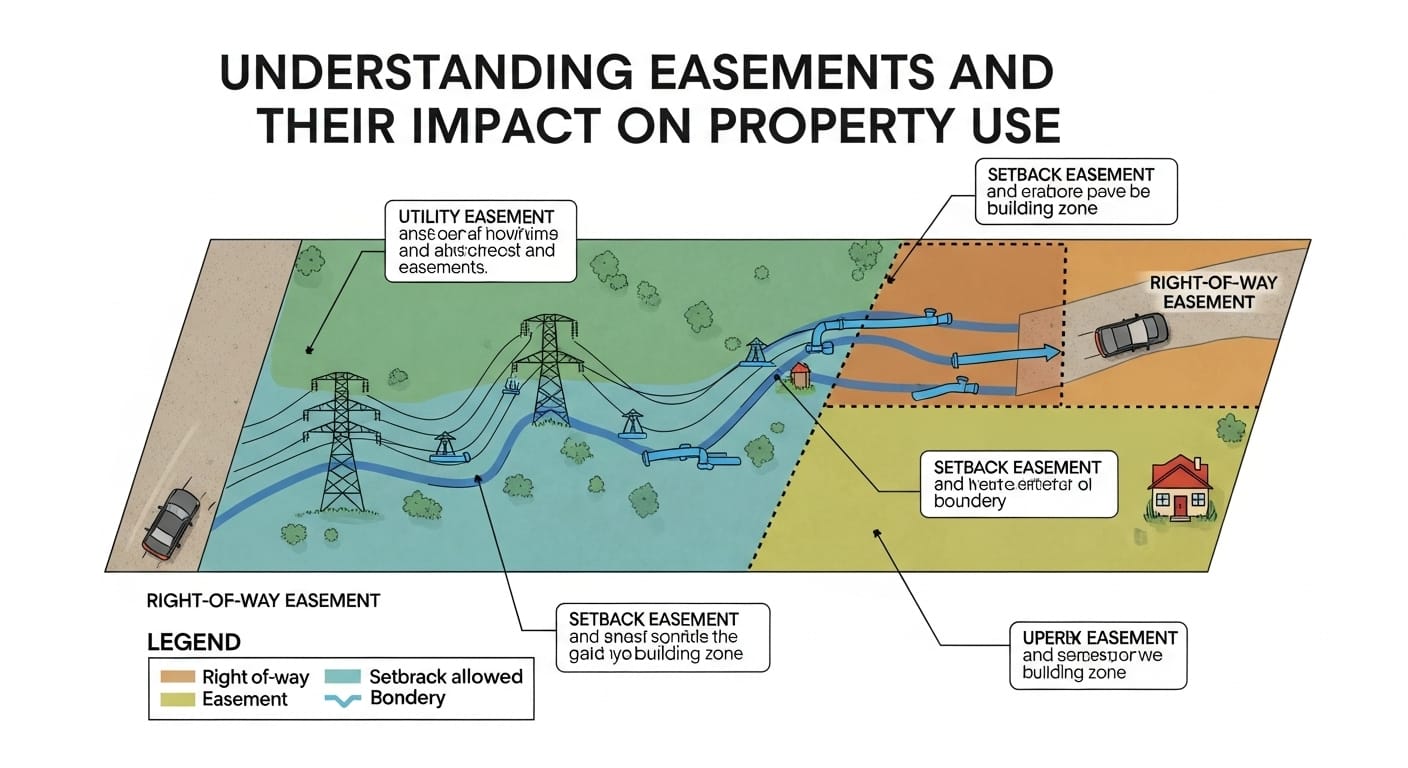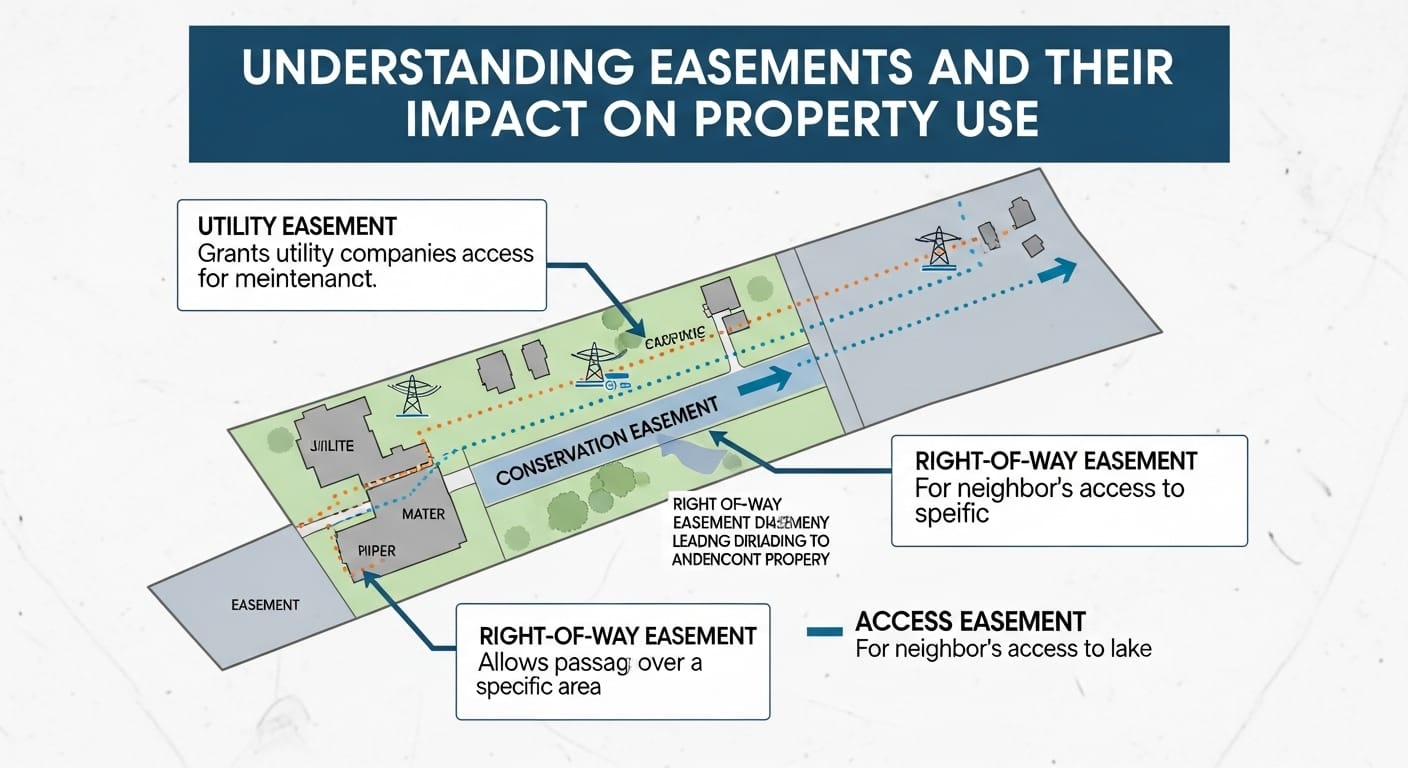Please Note: This post may contain affiliate links. If you click one of them, we may receive a commission at no extra cost to you. As an Amazon Associate, I earn from qualifying purchases.
Easements are one of those legal concepts that everyone nods knowingly about but secretly hopes they’ll never have to deal with. If you own property or are thinking of buying some, understanding easements is essential.
It’s not the most glamorous topic—no one’s building a theme park around the “Thrills of Easements”—but trust me, if you don’t know how they work, they can sneak up on you in the worst way.
Simply put, an easement is a legal right to use someone else’s land for a specific purpose. That might sound harmless, but in practice, it can get surprisingly complicated. It’s like finding out someone has a VIP pass to your backyard and they’re planning to use it every Tuesday at 6 a.m. for Zumba classes. Let’s unpack this with a bit of humor and a lot of detail.

Top Takeaways and Key Concepts
Understand that an easement is a legal right to use someone else’s property for a specific purpose.
Recognize the types of easements: appurtenant, in gross, and prescriptive, each with unique legal implications.
Know how easements are established through written agreements, implied use, or long-term prescriptive rights.
Both property owners have responsibilities: dominant estate must follow terms; servient estate must allow proper use.
Resolve disputes through communication first, but consult a lawyer or go to court if necessary.
Summary of This Article
The article explains easements, legal rights allowing someone to use another’s property, and their impact on property ownership. It covers types of easements, including appurtenant, in gross, and prescriptive, and details how they are established through agreements, long-term use, or necessity. Responsibilities of both property owners are emphasized to prevent conflicts, and the article outlines common dispute resolutions, including friendly negotiation or legal action. Termination of easements is also discussed, along with the importance of consulting a real estate attorney to navigate complex easement issues and protect property rights.
What Exactly is an Easement

To get started, let’s define an easement in practical terms. Imagine you own a beautiful piece of land. It’s your slice of paradise until you discover that your neighbor has the legal right to cross your property to access theirs. That’s an easement. They don’t own your land, but they have a legal ticket to use part of it.
Easements can exist for all sorts of reasons. Maybe there’s a utility company with underground cables running through your yard. Or perhaps there’s a shared driveway that’s been in place longer than disco music. These are all examples of easements in action.
Interestingly enough, easements can be created in several ways. Some are written into property deeds, while others arise from long-standing use or necessity. And yes, the law does care if your neighbor has been crossing your land for years without permission.
Types of Easements
Easements come in a delightful variety, each with its own quirks. The most common type is an easement appurtenant, which connects two properties. For instance, if your neighbor needs to cross your land to get to their house, that’s an easement appurtenant. It’s tied to the land, not the person, so it sticks around even if the property changes hands.
Another type is the easement in gross. This one isn’t tied to a neighboring property but to an individual or entity, like a utility company. If the local power company has the right to access your yard to maintain their lines, that’s an easement in gross.
By the way, there are even prescriptive easements, which can arise from long-term use without permission. It’s a bit like squatter’s rights but sneakier.
How Easements Are Established
Easements can be created in several ways, and the process often depends on the situation. The most straightforward method is through a written agreement, where the terms of the easement are laid out in black and white. This is common when properties are sold or divided.
Then again, there are implied easements, which aren’t written down but are considered legally valid because of the way the properties are used. For example, if a shared driveway has been used for decades, the law might recognize it as an easement even if there’s no official agreement.
Speaking of which, prescriptive easements can be particularly tricky. If someone has been using part of your property openly and continuously for a certain period, they might gain legal rights to it. Yes, it’s as frustrating as it sounds.
Rights and Responsibilities of Property Owners
When it comes to easements, property owners on both sides have rights and responsibilities. The person using the easement (called the dominant estate) must stick to the terms of the agreement. If the easement is for a driveway, they can’t suddenly decide it’s a great spot for a petting zoo.
On the other hand, the property owner (known as the servient estate) must respect the easement. They can’t block access or interfere with its intended use.
Honestly, easements work best when both parties communicate and cooperate. If everyone knows the rules and respects them, there’s less room for conflict.
Resolving Easement Disputes
Disputes over easements can turn neighborly relations sour faster than you can say “survey markers.” Common conflicts include disagreements over boundaries, excessive use, or changes to the easement’s purpose.
The first step in resolving these issues is usually a friendly conversation. All things considered, most disputes can be settled without involving lawyers. But if talking it out doesn’t work, legal action may be necessary.
In many cases, disputes end up in court, where a judge will interpret the terms of the easement and decide on a resolution. It’s not ideal, but sometimes it’s the only way to get clarity.
Terminating an Easement
Easements aren’t always forever. They can be terminated in several ways, such as when the purpose of the easement no longer exists. For example, if a shared driveway is replaced by a public road, the easement might no longer be necessary.
Easements can also be terminated by agreement. If both parties decide the easement is no longer needed, they can sign a legal document to end it.
Interestingly enough, abandonment can also lead to termination. If the easement isn’t used for a long time and there’s clear intent to abandon it, the courts might decide it’s no longer valid.
Seeking Legal Advice
If you’re dealing with an easement and you’re not sure where you stand, it’s a good idea to consult a lawyer. Easements can be legally complex, and having an expert on your side can save you time, money, and headaches.
A good real estate attorney can review the terms of the easement, explain your rights, and help you navigate any disputes. It’s like having a GPS for the confusing world of property law.
Resources
Understanding Easements and Land Use Rights
http://www.easementbasics.com/land-use-rights
Legal Advice for Easement Disputes
http://www.easementlawyers.org/disputes
How to Terminate an Easement Legally
http://www.propertylaws.net/terminate-easement
Frequently Asked Questions
What is an easement in property law?
An easement is a legal right that allows someone to use another person’s property for a specific purpose, such as access, utilities, or shared driveways.
What are the main types of easements?
The primary types are appurtenant, in gross, and prescriptive. Each varies based on whether the right is tied to land ownership, an individual, or long-term use.
How can an easement be established?
Easements can be created through written agreements, long-term usage (prescriptive), or implied necessity when land use requires shared access.
Can easements be terminated?
Yes, easements can end when their purpose no longer exists, through mutual agreement, or by abandonment if unused for an extended period.
What responsibilities do property owners have with easements?
The dominant estate must use the easement only as agreed, while the servient estate must not obstruct lawful use or restrict access.
How are easement disputes typically resolved?
Disputes are often settled through communication or mediation. If unresolved, legal action may be required to clarify rights or boundaries.
Why should I consult a lawyer about easements?
Easement laws are complex. A real estate attorney can review terms, protect your rights, and guide you through creation, modification, or disputes.

Kevin Collier is a legal expert passionate about simplifying complex legal concepts for everyday individuals. With a focus on providing clear, practical information, he covers a wide range of topics, including rights, responsibilities, and legal procedures. Kevin aims to empower readers with the knowledge they need to navigate the legal landscape confidently, ensuring they can make informed decisions regarding their legal matters. Through insightful articles and easy-to-understand resources, he helps demystify the law, making it accessible to all.










